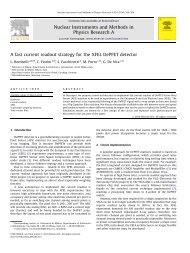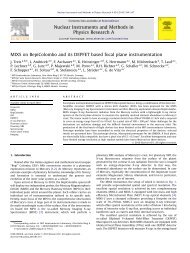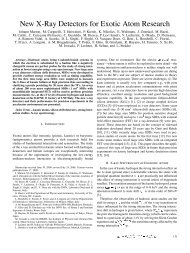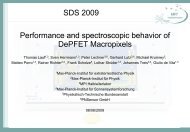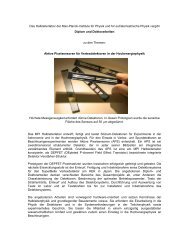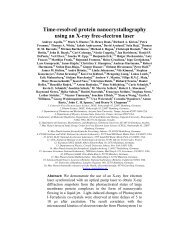DEPFET Sensor with Intrinsic Signal Compression ... - MPG HLL
DEPFET Sensor with Intrinsic Signal Compression ... - MPG HLL
DEPFET Sensor with Intrinsic Signal Compression ... - MPG HLL
You also want an ePaper? Increase the reach of your titles
YUMPU automatically turns print PDFs into web optimized ePapers that Google loves.
<strong>DEPFET</strong> <strong>Sensor</strong> <strong>with</strong> <strong>Intrinsic</strong> <strong>Signal</strong> <strong>Compression</strong>Developed for Use at the XFEL Free Electron Laser RadiationSourceG. Lutz, P. Lechner,PN<strong>Sensor</strong> GmbH, MünchenM. Porro, L. Strüder, G. De Vita,Max-Planck Institut für extraterrestrische Physik, MünchenAll at MPI Semiconductor Laboratory, Otto Hahn Ring 6, D81739 München, Germany11 th European Symposium on Semiconductor DetectorsWildbad Kreuth, June 7-11, 2009Wildbad Kreuth 2009 Gerhard Lutz, PN<strong>Sensor</strong> GmbH 1
Introduction• Development initialized by requrements of experiments at the futureXFEL (X-ray Free Electron Laser) X-ray source in Hamburg• Time structure: bunches of 3000 pulses<strong>with</strong> 200 fs duration and 200ns spacingevery 100 µs• Photon energy range 500eV to 20keV• Desired detector requirements:o Single photon detection capabilityo Very high dynamic range(10 4 photons of 1keV)o 5 MHz readout capability• Required measurement precision:o For low signal: good enough for distinction of single photon from noiseo At high signal: better than Poisson fluctuation of expected photons• Detector concept based on <strong>DEPFET</strong> (Depleted Field Effect Transistor)invented already 1985 <strong>with</strong> new modifications providing signal compressionand very high charge handling capacitance.Wildbad Kreuth 2009 Gerhard Lutz, PN<strong>Sensor</strong> GmbH 2
<strong>DEPFET</strong> Basics<strong>DEPFET</strong> (Depleted Field Effect Transistor) Principle• Structure: FET on fully depleted bulk• Function:• <strong>Signal</strong> charge collectedin potential minimum(internal gate) belowtransistor channel• steers transistor current• Clearing by positivepulse on clear electrode• Properties:• Combined function of sensor,amplifier and memory cell• Use as readout element in semiconductor detectors and• as building block of semiconductor pixel detectors.Wildbad Kreuth 2009 Gerhard Lutz, PN<strong>Sensor</strong> GmbH 3
<strong>DEPFET</strong> propertiesCircularlinear•Charge collection by drift mechanism overfull wafer thickness•low capacitance ► low noise•<strong>Signal</strong> charge remains undisturbed by readout ► repeated readout possible•Complete clearing of signal charge ► no reset noise•Full sensitivity over whole bulk ► large signal for m.i.p.; X-ray sens.•Thin radiation entrance window on backside ► X-ray sensitivity•Charge collection also in turned off mode ► low power consumption•Measurement at place of generation ► no charge transfer (loss) ►Operation over very large temperature range ► no cooling neededWildbad Kreuth 2009 Gerhard Lutz, PN<strong>Sensor</strong> GmbH 4
<strong>DEPFET</strong> <strong>with</strong> <strong>Intrinsic</strong> <strong>Signal</strong> <strong>Compression</strong>: PrincipleExample: linear geometry• Internal Gate (IG) extendsinto the region below thesource (S)• Small signal chargesassemble below the gate (G)channel region providing fullsteering of the transistorcurrent• Larger charges distributedbetween channel and sourceregions. Only a fraction ofcharge is effective in steeringthe transistor current• Result: non-linear currentchargecharacteristicsWildbad Kreuth 2009 Gerhard Lutz, PN<strong>Sensor</strong> GmbH 5
<strong>DEPFET</strong> layout for XFELXFEL pixel cell• Very small <strong>DEPFET</strong> <strong>with</strong>• Small central drain• Short gate• Very large source• Internal gate extendingbelow source• Clear structure• Combine <strong>DEPFET</strong> <strong>with</strong>hexagonal drift diode• Geometry:• <strong>DEPFET</strong> diameter 100µm• Cell diameter 236µmWildbad Kreuth 2009 Gerhard Lutz, PN<strong>Sensor</strong> GmbH 6
<strong>DEPFET</strong> SimulationXFEL pixel cell• Device Simulations• along radial direction from centredrain (r=0) to cell rim (r=118µm),wafer thickness 280µm.Simulationcut• Technology simulation (DIOS)providing doping profiles followedby• 2-D Device simulation (TESCA)providing potential distribution,electron- and hole concentrations,currents, and further quantities asfunction of applied voltages andtime.Wildbad Kreuth 2009 Gerhard Lutz, PN<strong>Sensor</strong> GmbH 7
Static simulation: : PotentialFull simulation region:<strong>DEPFET</strong> at lower left•<strong>DEPFET</strong> regionWildbad Kreuth 2009 Gerhard Lutz, PN<strong>Sensor</strong> GmbH 8
Dynamic simulation: : Charge collection and signal response• Compare charge collection and signalgeneration for photon interaction nearentrance window in centre position andclose to the rim.• <strong>DEPFET</strong> in common sourceconfiguration (drain current readout)<strong>with</strong> 77.5 µA drain current• Generated charge 1 fC corresponding to6250 e-h pairs or 23 photons of 1keV• Charge collection time25 ns for central interaction60 ns for rim position• <strong>Signal</strong> settling time almost equal indrain readout configurationWildbad Kreuth 2009 Gerhard Lutz, PN<strong>Sensor</strong> GmbH 9
Simulation: Non–linearresponse and signal compression• Properties were tuned torequirements of XFEL requiringsimultaneously• single X-ray sensitivity downto500eV energy• and the capability to collect10000 photons per pixel.• A linear region up to ~1.5fC(corresponding to 35 1keVphotons) provides highamplification: 1,8 µA/fCcorresponding to 77nA/1keVphoton.• It is followed by a non-linear(signal compression) region.• Compared to linear extrapolationfrom the low signal region, areduction of a factor 20 in theoutput signal range is achieved.Wildbad Kreuth 2009 Gerhard Lutz, PN<strong>Sensor</strong> GmbH 10
Simulation: <strong>DEPFET</strong> properties at working point• Working point chosen so as toachieve required properties atreasonable power consumption:Vdrain = - 3VIdrain = 78 µAWildbad Kreuth 2009 Gerhard Lutz, PN<strong>Sensor</strong> GmbH 11
Simulation: Choice of readout configuration• Possibilities:• Drain current readouto Direct coupling of detector toelectronics• Source voltage readouto AC coupling to electronicso Simplifies task of electronics(no base current compensationneeded)o requires integration of couplingcapacitor and source resistorinto detectoro Brings significant complicationto detector fabricationo Slows signals down due tocapacitive output loadWildbad Kreuth 2009 Gerhard Lutz, PN<strong>Sensor</strong> GmbH 12
From Pixel to Matrix<strong>DEPFET</strong> cell <strong>with</strong> two metal layers connecting• Source(S), Gate(G), Driftring (R1) kept atDC potentials• Clear (CL) and Clear-gate (CLG) <strong>with</strong>pulsed signalsDEFET matrix:• Every second columnhas cells mirrorimaged aroundhorizontal axis• Drains are connectedindividually bybump bonding toelectronics waferWildbad Kreuth 2009 Gerhard Lutz, PN<strong>Sensor</strong> GmbH 13
Summary• The new <strong>DEPFET</strong> structure provides simultaneously• good energy resolution for small signals,• signal compression and• very high charge handling capacity.• Combined <strong>with</strong> a silicon drift diode it forms the basic cell of a pixeldetector to be used at the XFEL Free Electron Laser X-ray radiation source.• The high sensitivity for low signals allows• single photon detection and• <strong>Signal</strong> compression• strongly reduces the output signal range• still keeping the measurement errorfar below statistical fluctuations in the number of produced photons.• The detector simplifies significantly the task of the readout electronicsWildbad Kreuth 2009 Gerhard Lutz, PN<strong>Sensor</strong> GmbH 14
SummaryTHE ENDWildbad Kreuth 2009 Gerhard Lutz, PN<strong>Sensor</strong> GmbH 15



